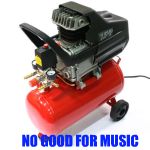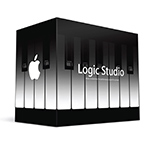
UPDATE: I have created Fluke which makes playing FLACs through iTunes on a Mac much easier. Neither Fluke nor the instructions will work for Windows users though, sorry. Winamp?
Some time ago I had acquired a collection of certain Beatles recordings in FLAC format (65 pounds of Beatles vinyls on my shelf keep me guilt-free), and since the only lossless format iPods would play was Apple Lossless, converting to that format was my only option. Now, while I support the great idea of open lossless that is FLAC, Apple has really been a bitch about implementing it into iTunes. There have been rumours support for it will be present when Leopard comes along, but I think we’ll more likely see native support for WMA files than FLAC.Before today, the method I used to use was: I would take the album in FLAC, put it through xACT which would convert it to .AIFF, effectively doubling the number of song files on my hard drive and getting rid of all the tags entirely; then importing those .aiff files into iTunes, tagging them by hand a little bit, converting the result to Apple Lossless, getting rid of the intermediate .aiff files, and then putting everything through iEatBrainz, the automatic tagging software which bases its algorithm on a checksum of the audiofile, and not the length of all tracks like iTunes does. Now, on their website, the creators of iEatBrainz failed to mention that it doesn’t fucking work most of the time, so I would end up tagging almost everything by hand.Today, I got seriously pissed off at not being able to instantly listen to A Hard Day’s Night, and instead of ripping the LP like I wanted to, I found a workaround for this. Here is what you do.
 No matter what music you compose, you’ll eventually have to deal with compressors. There is just no escaping. Compressors are what you apply to make music better. That’s right. They help you make your music beyond studio quality. You’re one plug-in away from stardom!
No matter what music you compose, you’ll eventually have to deal with compressors. There is just no escaping. Compressors are what you apply to make music better. That’s right. They help you make your music beyond studio quality. You’re one plug-in away from stardom! Machines are designed to help us. While they mostly cause nothing but headaches, they can come in handy when you program them right. The continuing story of the Beatles bootlegs has prompted me to start learning AppleScript to automate a number of tasks I typically perform on tags within iTunes, but then I realized that my problems are probably far from unique. Indeed, there are other nerds out there who have already written a number of useful scripts of us to use. Unfortunately, it takes being a geek to find geeky things, so here is a nice pretty Best Of compilation of useful iTunes scripts for all you people who don’t feel like dipping into the nerd scene.
Machines are designed to help us. While they mostly cause nothing but headaches, they can come in handy when you program them right. The continuing story of the Beatles bootlegs has prompted me to start learning AppleScript to automate a number of tasks I typically perform on tags within iTunes, but then I realized that my problems are probably far from unique. Indeed, there are other nerds out there who have already written a number of useful scripts of us to use. Unfortunately, it takes being a geek to find geeky things, so here is a nice pretty Best Of compilation of useful iTunes scripts for all you people who don’t feel like dipping into the nerd scene.


 From what I see working at an Apple Reseller store here in Vancouver, MacBooks are currently the hottest selling computers by Apple. Despite the infamous random shutdown, despite the occasional overheating, and yellowing of the case, the sales are quite high.
From what I see working at an Apple Reseller store here in Vancouver, MacBooks are currently the hottest selling computers by Apple. Despite the infamous random shutdown, despite the occasional overheating, and yellowing of the case, the sales are quite high.